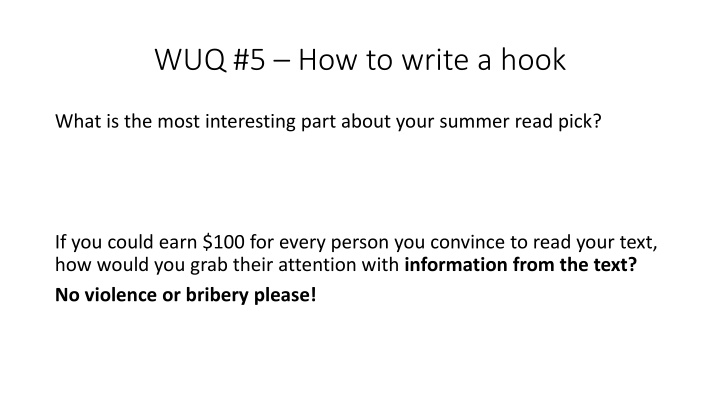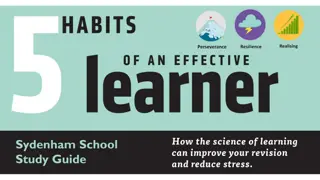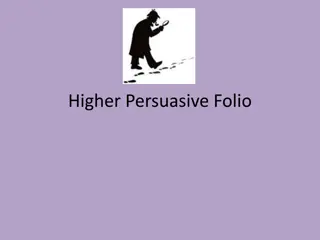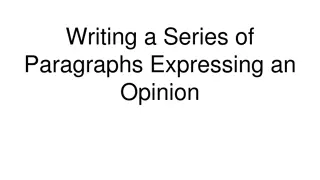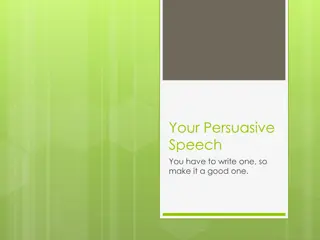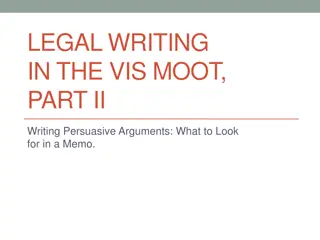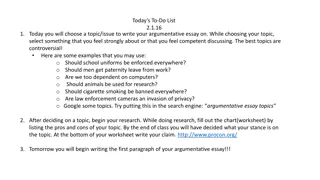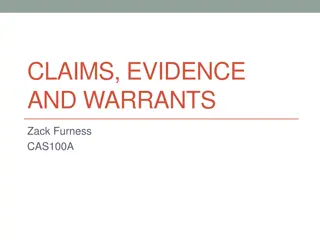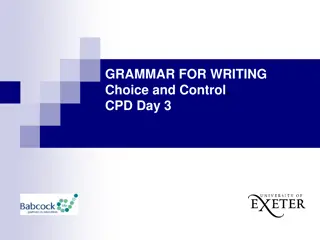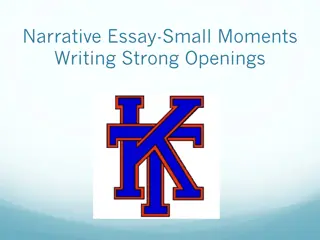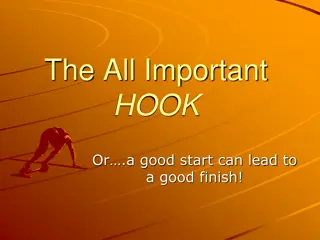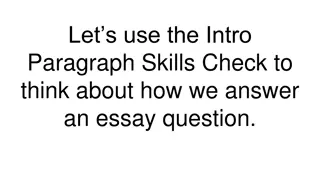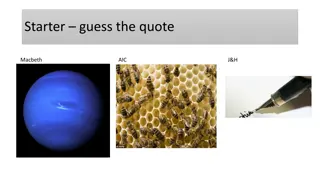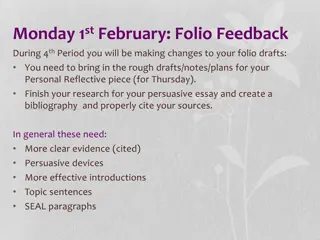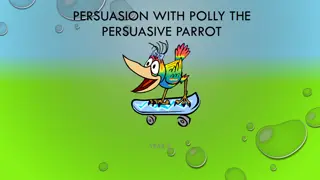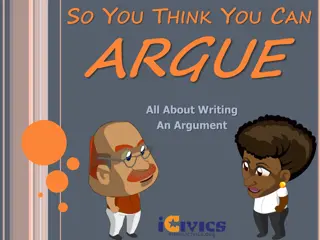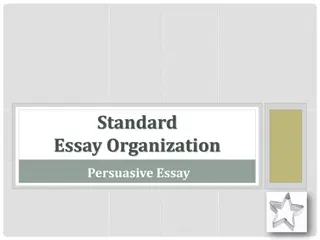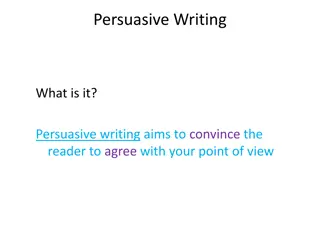Crafting Compelling Hooks for Persuasive Writing
Learn how to create engaging hooks that captivate your readers and persuade them to delve into your text. Explore the art of hook writing using impactful examples and strategies to grab attention effectively without resorting to violence or bribery, enhancing your writing skills and engaging your audience.
Download Presentation

Please find below an Image/Link to download the presentation.
The content on the website is provided AS IS for your information and personal use only. It may not be sold, licensed, or shared on other websites without obtaining consent from the author.If you encounter any issues during the download, it is possible that the publisher has removed the file from their server.
You are allowed to download the files provided on this website for personal or commercial use, subject to the condition that they are used lawfully. All files are the property of their respective owners.
The content on the website is provided AS IS for your information and personal use only. It may not be sold, licensed, or shared on other websites without obtaining consent from the author.
E N D
Presentation Transcript
WUQ #5 How to write a hook What is the most interesting part about your summer read pick? If you could earn $100 for every person you convince to read your text, how would you grab their attention with information from the text? No violence or bribery please!
STATEMENTPROOFANALYSIS SPA FOR WRITING BODY PARAGRAPHS
Example Hooks JFK Hook: Throughout history most political speeches are informative, but the best ones are persuasive. For example, JFK s 1961 inaugural address demonstrates the power to inspire the American people and other nations with his iconic quotes and allusions to seminal moments and figures in history.
READ the text carefully and understand what you have read. Identify author s thesis or main idea/argument Writing a Thesis Writing a Thesis Statement Statement Use the thesis generator strip to create a thesis on how Kubrin and Nielson use the appeals in Rap Lyrics on Trial.
STATEMENT Is a CLAIM A claim is an arguable arguable statement that must then be supported with supported with excellent evidence. excellent evidence.
STATEMENT In the excerpt from Hidden Figures , Margot Lee Shetterly asserts that black women were just as qualified to work at Langley Lab in the mid-1900 s as everyone else was, and suggests that the integration of these women helped to create desegregated work places everywhere. She supports her claim by using logos in demonstrating the qualifications of the black women, ethos through her academic tone with minimal bias and pathos to convey the difficulty of introducing these women into a previously segregated working environment. Shetterly appears to write in hopes of informing the audience about how minorities can make huge changes in the world in order to inspire a new generation of minorities to make great improvements in society. Shetterly s use of a formal tone makes it seem as if she is writing for an educated, mostly unbiased audience that is looking to learn more about segregation in recent society. Is a CLAIM A claim is an arguable statement that must then be supported supported with excellent with excellent evidence. evidence. Let s extract the claims Let s extract the claims from this rhetorical from this rhetorical precis. precis. arguable
Finding a Statement/Claim Refer back to your Group RA Poster on Rap Lyrics on Trial. Create 3 claims about how the authors use the appeals to achieve their purpose. For example: Nielson and Kubrin successfully employ pathos through the use of loaded language.
Proof is evidence This is how you support, or back up, your claims. The evidence will help to "prove" each claim to the reader.
Finding Evidence Look to Rap Lyrics on Trial and find the MOST EFFECTIVE evidence that supports your claims.
Example of Proof Kubrin and Nielson use loaded language when describing how rappers (and young men of color) are stereotyped as violent, hypersexual, and dangerous by their own lyrics (para. 9, 2014).
Analysis Breaks down the evidence - goes into detail about the effects on the audience. Explain how the evidence reinforces the appeal, and how it furthers the author s purpose.
SUMMARY VS ANALYSIS Summary: Johnson has a lot of formal language throughout his paper and hardly uses any informal words. Rhetorical Analysis: Johnson employs formal language throughout his essay. For example, he argues unequal funding in public schools creates a horrific imbalance between affluent communities and those that are impoverished (27). In using formal, academic writing, he establishes himself as a credible and valid author, which creates a strong appeal to ethos. Furthermore, Johnson has been a district resource manager for 20 years, which makes him a reliable voice in speaking on the disproportionate allocation of funds. This, in conjunction with his use of emotional words like horrific to create guilt in the audience, can persuade votes for more funding for low income communities. *This analysis focuses on diction that creates ethos and pathos
SUMMARY VS ANALYSIS Summary Summary: Kubrin and Nielson use pathos to discuss whether or not rap lyrics should be used as evidence in a court conviction by using loading language to tug at the audience s emotions. Rhetorical Analysis: Rhetorical Analysis: Kubrin loaded language in order to loaded language in order to convince the Supreme court and potential jurors that lyrics convince the Supreme court and potential jurors that lyrics should not be used as evidence in a conviction. should not be used as evidence in a conviction. For instance, when rappers (and young men of color) are stereotyped as violent, hypersexual, and rappers (and young men of color) are stereotyped as violent, hypersexual, and dangerous (para. 9, 2014) by their own lyrics, the audience is compelled to a sense of dangerous (para. 9, 2014) by their own lyrics, the audience is compelled to a sense of outrage and injustice. outrage and injustice. Appealing to a reader s sense of justice will perhaps sway them to Appealing to a reader s sense of justice will perhaps sway them to side with authors. On the other hand, these same words may also evoke emotions such side with authors. On the other hand, these same words may also evoke emotions such as intimidation in the reader, and can have the opposite effect of siding against the as intimidation in the reader, and can have the opposite effect of siding against the authors. authors. Kubrin and Nielson and Nielson successfully employ pathos through the use of successfully employ pathos through the use of For instance, when describing how describing how *This analysis focuses on diction that creates pathos
Student Sample Nielson and Kubrin successfully employ logos through the use of statistics in order to push the claim that rap lyrics negatively affect trials. They state Last year, the American civil liberties union of New Jersey found that 18 cases in which various courts considered the admissibility of rap as evidence, the lyrics were allowed nearly 80 percent of the time (para. 8, 2014). By using these statistics, the authors show how often rap lyrics are used in court cases and how often they get accepted as valid forms of evidence against the defendant. These lyrics negatively impact the outcomes of court cases when used as evidence instead of artistic expressions.
The author uses pathos to support his claim by appealing to the audience s sense of fairness. For instance, in the article it states, when that art reinforces stereotypes about young men of color as violent, hypersexual, and dangerous. If that s all jurors see, what are the chances of a fair trial? (par. 10, 2014) By using word choice such as stereotypes, the author s tone indicates their own bias of inequality in the situation. This tone, tied to the mention of biased stereotypes makes the readers realize that the use of rap lyrics as evidence in the court of law results in unfair biases which results in a sway of the jurors opinion. - Kaley Guhl
Example of Proof JFK uses words that have a dramatic effect on the audience, such as, to those struggling to break the bonds of mass misery.
CLAIMS - Comparing the weak and strong JFK uses pathos in his inaugural JFK uses pathos in his inaugural address. address. The first example is weak because it presents information that is vague. The second example not only tells the reader which appeal is used, but HOW HOW it is used (i.e. emotionally charged language). JFK successfully employs pathos JFK successfully employs pathos through emotionally charged through emotionally charged language. language.
No Analysis: Claim + Evidence JFK successfully employs pathos through emotionally charged language. The newly elected president uses phrases such as, to those struggling to break the bonds of mass misery.
Weak Analysis Claim Claim: JFK successfully employs pathos through emotionally charged language. Evidence Evidence: The newly elected president uses phrases such as, to those struggling to break the bonds of mass misery. Analysis Analysis: This creates a dramatic effect on the audience. Analysis doesn t relate relate evidence to claim. i.e. WHAT emotions are felt by audience?
Strong Analysis This image of a shackled and downtrodden population invokes feelings of sympathy and remorse in the audience. As they envision this suffering, a sense of obligation to help others in need is crafted by JFK. This analysis explains why the evidence supports the claim regarding the effectiveness of the rhetorical devices.
Put it all Together! Statement/Proof/Analysis The strongest appeal used in the speech is pathos, which is successfully employed through emotionally charged language.The newly elected president uses phrases such as, to those struggling to break the bonds of mass misery (para. 15) to evoke images of a shackled and downtrodden population. This, in turn, stirs feelings of sympathy and remorse in the audience. As they envision these suffering villagers, a sense of obligation to help others in need is crafted by JFK. This strong emotion furthers JFK s goal of uniting us with other nations.
Put it all Together! Statement/Proof/Analysis First and foremost, Kennedy integrates pathos effectively throughout his speech, using strong diction to evoke powerful emotions into the heart of his audience. He states, that both sides begin anew the quest for peace, before the dark powers of destruction unleashed by science engulf all humanity in planned or accidental self- destruction (para.12). This strikes a sense of urgency and fear into his audience. Through his use of apocalyptic language, the severity of this impending destruction becomes very real into the listeners minds. The thought of all of humanity being engulfed by these dark powers is terrifying and the idea that it could be right around the corner influences the audience to take immediate action. This is just one tactic JFK uses to bring the nation together on this quest for peace.
Verbs for college-level analysis *Replace your weak verbs with strong verbs Weak Strong Implies Suggests compares Emphasizes Defines Dismisses Narrates Analyzes Questions Contrasts Argues Ridicules Praises Establishes Minimizes Qualifies Says This quote shows Relates Explains Goes on to say States Tells Shows
WRITING YOUR CONCLUSION WRITING YOUR CONCLUSION Restate thesis Restate thesis does the author use the appeals effectively to achieve their purpose? Restate claims Restate claims HOW does the author use the appeals? End with an insightful thought End with an insightful thought if you can t imagine dropping the mic, then it s not good enough! Rough Drafts due to TII tomorrow night! Hardcopy due BLOCK DAY
Lets Evaluate By effectively utilizing rhetoric to present himself as an informed and diplomatic leader as well as inspiring a sense of responsibility to rise to the occasion in his audience, Kennedy successfully created a speech that compelled both Americans and the rest of the world to consider what they can do for their country in an effort to achieve peace. Though the Cold War would not technically end for another roughly thirty years, John F. Kennedy s Address stands as a testament to the moving power of skillfully utilizing language and presentation of logic in a sound manner. In a time where anyone can say anything at any point, we can all stand to be reminded that words are not weapons to be cobbled together for the sake of throwing, but pieces of art, lovingly crafted, to be set free unto those who listen. 1. Does the student restate the author s purpose? 2. Does the student evaluate the author s effectiveness? 3. Do they restate how the appeals were used to achieve the author s purpose? 4. Is there a thoughtful ending (worthy of a mic drop)?
Whats due? TONIGHT: Rough Draft to TII BLOCK DAY: hardcopy of rough draft in class
